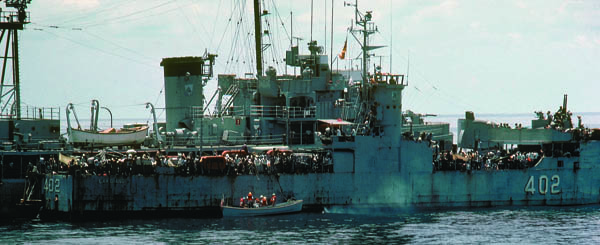
Kirk received a surprising radio message while en route with refugees: “We’re going to send you back to rescue the Vietnamese navy. We forgot ’em.”
Saigon was falling. Since the collapse of Ban Me Thuot in the Central Highlands on March 10, 1975, the South’s Army of the Republic of Vietnam (ARVN) had been in disorderly retreat, hoping to redeploy its forces and hold an enclave south of the 13th parallel. The rapid pace of defeat came as a surprise to American and South Vietnamese generals, as well as to the North Vietnamese who, supported by artillery and armor, drove relentlessly toward Saigon after capturing Hue and Da Nang. By the end of March, hopes of halting the advance on the capital were abandoned by Central Intelligence Agency officers who believed nothing short of B-52 strikes on Hanoi could reverse the offensive. By April 20, the North’s People’s Army of Vietnam (PAVN) forces had overrun Xuan Loc, the last line of defense before Saigon. With that, President Nguyen Van Thieu resigned and denounced the United States for not coming to the aid of South Vietnam. By April 27, Saigon was encircled by more than 100,000 PAVN troops. It was widely feared that a bloodbath of reprisals against Vietnamese who had worked with Americans would accompany a Communist victory.
In Washington, the Ford Administration had begun planning a complete evacuation of Americans. The Pentagon wanted to get them out as fast as possible to avoid casualties, but U.S. Ambassador Graham Martin tried to keep the evacuation as quiet and orderly as possible, to avoid total chaos and the possibility of South Vietnamese turning against fleeing Americans. President Gerald Ford still hoped to gain additional military aid for South Vietnam and pushed Congress to approve $722 million to rebuild South Vietnamese forces destroyed in the past month’s rout. Secretary of State Henry Kissinger was opposed to a full-scale evacuation as long as the aid option remained on the table.
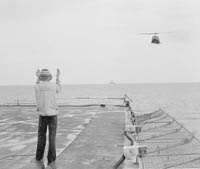 While Americans were assured evacuation, South Vietnamese, desperate to leave Saigon, had to resort to under-the-table payments to secure passports and visas. The price of seagoing vessels tripled, and evacuees moved in droves to anything that would float or fly and headed for the South China Sea, where the U.S. Navy’s Seventh Fleet task force stood by to support the evacuation.
While Americans were assured evacuation, South Vietnamese, desperate to leave Saigon, had to resort to under-the-table payments to secure passports and visas. The price of seagoing vessels tripled, and evacuees moved in droves to anything that would float or fly and headed for the South China Sea, where the U.S. Navy’s Seventh Fleet task force stood by to support the evacuation.
Among the dozens of ships that would be fated to play a large role in the rescue of tens of thousands of refugees was a small destroyer escort, USS Kirk. With a crew of 250 sailors, it had already participated in the evacuation of Phnom Penh, Cambodia, weeks earlier. As a submarine hunter, its crew was trained for warfare, but the ship never did see combat during the Vietnam War. Little did Kirk’s Commander Paul Jacobs and crew imagine that, in the closing days of the war, they would become key players in a secret mission of historic proportions—of which their role would not be officially recognized for more than three decades.
As the embassy began to allow a trickle of its own Vietnamese employees to leave, Assistant Defense Secretary Erich von Marbod and his aide, Richard Armitage, sent by Secretary of Defense James Schlesinger, arrived on April 24 to prevent additional U.S. military equipment from falling into Communist hands and to pressure Ambassador Martin to evacuate gold bullion from Saigon’s treasury. Von Marbod had already arranged with the Thais to let him use several bases in Thailand to park planes and equipment he hoped Martin would allow him to spirit out. Armitage was to work with the Vietnamese navy to devise a rescue plan for ships, crews and families. When Martin learned what they were up to, however, he was furious. The withdrawal of any military equipment from Saigon, he protested, would sabotage Vietnamese morale and destroy whatever chance existed for an orderly change in government. There would be a cease-fire in three days, Martin said. He believed there would be 30 days to form a coalition government and undertake the demilitarization of South Vietnam. Ambassador Martin assured von Marbod that he would then have “all the time in the world to salvage American materiel.”
The State Department had ordered a military flight to ferry $220 million in gold bullion from the Saigon treasury to the Federal Reserve Bank in New York. Martin, however, ordered the gold held in place to lend an aura of stability and add to the collateral it might bring in negotiations with the Communists.
Hoping to at least salvage planes and equipment outside of Saigon, von Marbod sent Armitage to Bien Hoa Air Force Base on April 28 to get out as much materiel as he could. Von Marbod also met with senior Vietnamese generals to suggest the air force prepare to fly its aircraft from Tan Son Nhut to Can Tho or Phu Quoc Island. He also asked them to schedule airstrikes against Bien Hoa airfield later in the day to destroy whatever materiel Armitage could not haul out. Within hours, however, reliable reports of a North Vietnamese advance to surround Bien Hoa were coming in and von Marbod had to reluctantly order Armitage to leave Bien Hoa.
Too late to save much of Vietnam’s air force, von Marbod and Armitage had one more ploy in mind—to save the Republic of Vietnam Navy (VNN) by moving the ships down the Saigon River to the open sea. At one time the VNN was one of the top 10 in the world, with 42,000 officers and men and 1,500 ships.
If anyone could save what was left of the VNN, it was Armitage. An Annapolis graduate and fluent in Vietnamese, Armitage had spent six years with the U.S. Navy in the Vietnam Riverine advisory force, rising to the rank of lieutenant commander. When the Nixon Administration signed the Paris Peace Accords in 1973, he considered it a sell out of the Vietnamese and in protest resigned his commission and left the Navy. Shortly after that, he then joined von Marbod at the State Department.
Von Marbod and Armitage arranged to meet with Captain Kiem Do, the VNN’s deputy chief of naval operations and an old friend of Armitage. Captain Do had day-to-day responsibility for deploying the navy’s ships. Von Marbod explained to him that Saigon had little time left. “Your navy should be ready to set sail with everything that will float and rendezvous at Con Son Island. After that a U.S. Naval task force will guide you to safety.”
Plotting for a branch of the military to leave the country at that time was an act of treason, so Do kept the plan a secret until the last possible minute. Pulling the sea force into the Saigon River too soon could set off a mass panic, and mutiny would be a distinct possibility. It was decided to begin moving ships down the Saigon River at 1800 hours on April 29. Early that morning, Do briefed his ship captains.
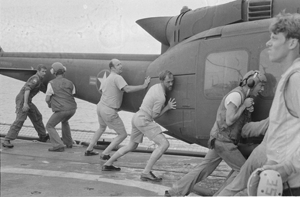 Many in the American mission, particularly Ambassador Martin, believed that negotiations with the Communists were still possible if Saigon could stabilize the military situation. Martin hoped North Vietnam’s leaders would allow a “phased withdrawal” whereby a gradual departure might be possible in order to allow Americans and their Vietnamese supporters to leave over a period of months. The ambassador intended to evacuate Saigon when necessary by use of fixed-wing aircraft from Tan Son Nhut airbase.
Many in the American mission, particularly Ambassador Martin, believed that negotiations with the Communists were still possible if Saigon could stabilize the military situation. Martin hoped North Vietnam’s leaders would allow a “phased withdrawal” whereby a gradual departure might be possible in order to allow Americans and their Vietnamese supporters to leave over a period of months. The ambassador intended to evacuate Saigon when necessary by use of fixed-wing aircraft from Tan Son Nhut airbase.
Before daybreak on April 29, however, rockets and heavy artillery had pounded the base, and captured South Vietnamese air force A-37Bs flown by North Vietnamese pilots bombed the airport runways and strafed the city.
Although Martin had been advised that fixed-wing evacuation was now impossible, he insisted on examining the damage himself as shells were still raining in on the base. Finally satisfied that Tan Son Nhut was out of service, the ambassador returned to the embassy, called Secretary of State Henry Kissinger and informed him that he had decided to immediately go to option four, Operation Frequent Wind, the helicopter evacuation of Americans and Vietnamese employees.
At noon the prearranged evacuation signal was broadcast over local Saigon radio: “It is 105 degrees and rising,” followed by Bing Crosby singing “White Christmas.” When they heard it, American officials, businessmen and journalists dropped everything and ran, knowing they now had only hours to get out. Senior Vietnamese officials were to report to the embassy and be grouped for evacuation on a priority basis.
As the frenzied operation began, U.S. helicopters crammed with evacuees began heading out to sea, where the Seventh Fleet task force awaited them. At the same time, dozens of unknown contacts began appearing on the ships’ radar screens. South Vietnamese army and air force helicopters, flown by their crews and loaded with family and friends, were following the American aircraft out to sea hoping to find a suitable ship on which to land.
Young man, I’m not used to having strange civilians come aboard my ship in the middle of the night and give me orders.
With the U.S. evacuation by helicopter in full swing and North Vietnamese shellfire increasing, Captain Do advanced the ship departures by four hours. Addressing the VNN headquarters staff, he had to shout to be heard above the pounding of artillery and the roar of helicopters. “It’s time to go! The enemy is closing in,” Do said. “You have two hours to gather your families and bring them to the ships. Don’t panic—there’s room for everyone.” Someone asked, “Does this mean we’re leaving the country?” Do shouted: “Yes, we have no choice. It’s that or capture.”
It was past midnight when Do, on one of the last ships to leave, shouted: “Cast off all lines. Left rudder full; engine one-third.” He sank into the captain’s chair of his old ship from coastal patrol days as small boats filled with people begging to be taken aboard chased after them. Some they stopped for, some they did not. Do could hardly believe that no one was shooting at them. He ordered a ship and communications blackout as the flotilla passed Vung Tau. They were now out of reach of enemy guns. It was time to worry about North Vietnamese air force and naval patrols.
In spite of von Marbod’s last-minute salvage efforts, equipment losses from the collapse of South Vietnam would be massive. According to Pentagon estimates, NVA forces captured more than $5 billion in U.S.-supplied hardware, including 550 tanks, 73 F-5 fighters, 1,300 artillery pieces and enough materiel to field an entire army, air force and navy.
But the human toll left behind was of more tragic proportions. The U.S. State Department estimated that during the war, Vietnamese employees of the American embassy and their families numbered 90,000. Ambassador Martin later admitted only 22,000 such people were evacuated before Saigon fell. According to Hanoi more than 200,000 South Vietnamese were sent to “reeducation camps” after the war.
“In terms of squandered lives, blown secrets and the betrayal of agents, friends and collaborators, our handling of the evacuation was an institutional disgrace,” said Frank Snepp, senior CIA analyst in Saigon, in his book Decent Interval. “Not since the abortive Bay of Pigs invasion of Cuba in 1961 had the agency put so much on the line, and lost it through stupidity and mismanagement.”
Standing by at sea, Kirk’s mission was to shoot down any North Vietnamese jets that might try to stop the exodus of helicopters, but the jets never came. Instead, the horizon was filled with scores of helicopters seeking some place to land. Dozens of UH-1s flew past Kirk, which had only a small flight deck, heading for the larger aircraft carriers. Commander Jacobs knew that many of the aircraft were dangerously low on fuel, so he ordered his men to make radio contact and invite them to land. There was concern among Kirk’s crew that the South Vietnamese pilots might not have had the skill to land on a moving flight deck. “Most of the pilots had never landed on a ship before,” recalls Donald Cox, an officer on Kirk. “They were army pilots and typically landed at fire zones, clearings in the brush or at an airport.”
A Huey flew to Kirk, landed safely and unloaded its passengers. Then a second Huey landed alongside. But as a third aircraft alighted on the small deck, its rotors chopped the tail off the second one. So with no room on deck to land others that were circling the ship, the crew started pushing the helicopters overboard into the sea.
Amid the chaos, a CH-47 Chinook lumbered toward Kirk. The crew frantically waved off the massive two-rotor aircraft, which could tear the ship apart attempting a landing. The pilot got the message but was determined to unload his passengers before running out of fuel. While Kirk cruised at about 5 knots, the Chinook hovered over the fantail and started dropping its human cargo to the deck 15 feet below. With sublime trust in the outstretched arms of the men below, a mother in the helicopter dropped her three children, including a 10-month-old baby. Kirk sailors said it was like catching basketballs. With his passengers offloaded, the pilot flew some 60 yards off Kirk’s deck, hovered a moment, then leaned the Chinook to the left and jumped out the right-hand door into the sea. As soon as the rotor blades hit the water, the aircraft exploded, ripping into small pieces. Crewmen dove into the water and saved the pilot. Kirk’s crew rescued more than 200 refugees from 16 heli-copters over a day and a half.
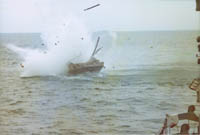 Since the siege of Saigon had begun, more than 50,000 people had been air-evacuated—some 7,000 of them flown out in helicopters on April 29. The very last American troops, 11 U.S. Marines, lifted off the embassy roof by helicopter at 7:53 a.m., April 30. Just three hours later, a single PAVN tank crashed through the gates of Saigon’s Presidential Palace. It had been 30 years since the first American soldiers in the OSS “Deer Team” had parachuted into Vietnam to support and train Ho Chi Minh and his guerrilla forces at the close of World War II.
Since the siege of Saigon had begun, more than 50,000 people had been air-evacuated—some 7,000 of them flown out in helicopters on April 29. The very last American troops, 11 U.S. Marines, lifted off the embassy roof by helicopter at 7:53 a.m., April 30. Just three hours later, a single PAVN tank crashed through the gates of Saigon’s Presidential Palace. It had been 30 years since the first American soldiers in the OSS “Deer Team” had parachuted into Vietnam to support and train Ho Chi Minh and his guerrilla forces at the close of World War II.
As the ships of Task Force 76 headed east with their loads of refugees and South Vietnamese helicopters, Kirk received a surprising radio message. The destroyer was to turn around and head back to Vietnam. Rear Admiral Donald Whitmire, commander of the evacuation mission aboard the command ship Blue Ridge, explained to Jacobs: “We’re going to have to send you back to rescue the Vietnamese navy. We forgot ’em. And if we don’t get them or any part of them, they’re all probably going to be killed.”
With that, Kirk set a bearing for Con Son Island, a sheltered complex of islands with an infamous history 50 miles off the coast and 150 miles south of Vung Tau. The French called it Poulo Condore and established a brutal penal colony there in 1861. During the Vietnam War, the South Vietnamese used it as a prison where many inmates were shackled in the infamous “tiger cages.”
Late on April 30, a 30-year-old civilian came aboard Kirk, without official orders, and met Commodore Donald Roane, the flotilla commander. The commodore wired the Pentagon to confirm the identity of Richard Armitage and his orders. “Young man, I’m not used to having strange civilians come aboard my ship in the middle of the night and give me orders,” Roane said to Armitage.
“Sir, I am equally unaccustomed to coming aboard strange ships in the middle of the night and giving orders,” Armitage replied. “But steam to Con Son.”
As the sun rose on May 1, Kirk reached Con Son to find 32 South Vietnamese navy vessels and dozens of cargo ships and fishing boats waiting as they expected. What they didn’t expect was that all of them would be overflowing with refugees, estimated to number 30,000, desperate to leave Vietnam.
“They were rusty, ugly, and beat up,” said Kent Chipman, a machinist’s mate on Kirk, sent out to inspect and repair the vessels. “Some wouldn’t start and were towing each other. And some were taking on water. We took our guys over and got the ones under way that would run. One cargo ship was so heavy it was sinking, and people below decks were bailing water with their shoes.”
“Kirk was ideal,” recalled Armitage. “It could communicate with the rest of the U.S. fleet and be able to rescue any of the folks who might be in harm’s way. Some had been wounded. Some were pregnant. All were sick after awhile. And we needed to take care of them.”
When Stephen Burwinkel, Kirk’s medic, saw the scene in front of him, he feared a humanitarian disaster was looming. Burwinkel immediately set out to get control of the situation, moving from ship to ship treating those suffering from dysentery, dehydration and diarrhea and those who had been injured. Dozens of pregnant women were gathered from the flotilla and transferred to one ship to make care easier. With thousands of needy charges, many of them babies and children, Burwinkel worked almost nonstop. Incredibly, over seven days, only three of the 30,000 refugees perished. One of the deaths was Bao Le, the infant son of Soan Le. Suffering a massive fever, the boy and his mother were moved to the captain’s stateroom on Kirk. When the year-old boy died, the rest of the family was brought aboard Kirk for a burial service at sea. Years later, Pierre Le recalled the funeral the sailors held for his son on the ship’s fantail: “The body of my son was wrapped under two flags; the Vietnamese flag and the American flag. Someone played taps. My son’s body was on a board, as the board tipped, the body slid into the dark South China Sea.”
After fixing what could be fixed and transferring people from the ships that would be left behind, Kirk led the flotilla toward the Philippines. As they headed out to sea, other U.S. Navy ships, including Mobile, Tuscaloosa, Barbour County, Denver and Abnaki, came in the escort to deliver food and help attend the sick.
When those flags came down and American flags went up, that was it – the last vestige of South Vietnam.
Finally reaching the Philippines after seven days and about 1,000 miles, Captain Jacobs got some bad news. “The Philippine government wasn’t going to allow us in, period,” Jacobs recalled, “because these ships belonged to the North Vietnamese now and they didn’t want to offend the new country.” Indeed, Philippine President Ferdinand Marcos, a staunch U.S. ally during the war, was one of the first to recognize the new Communist rulers now in control of Vietnam. Marcos had been disappointed to see the United States abandon its ally but thought it prudent to establish a correct and respectful relationship with the new Communist Vietnam. And the new power in Southeast Asia wanted its ships back.
Armitage knew there was no way the leaking ships, with their decks teeming with exhausted refugees, could limp on to Guam, so he and Captain Do came up with a solution that Marcos could live with. “We would raise the American flag and lower the Vietnamese flag as a sign of transfer of the ships back to the United States,” Do said. “Now the war is over, we turn them back to the U.S.”
In addition to the deft legal maneuver, Do saw the opportunity to do something important for the now nationless refugees. “We lost our country, lost our pride and lost everything,” he said. “We asked to have a ceremony that would save us face and our dignity.” A frantic search ensued to find 32 American flags, and then officers from Kirk were sent aboard each Vietnamese ship to take command after a formal flag ceremony. After speeches were made, the ships’ guns were disassembled, and identifying letters painted over.
“That was the last vestige of South Vietnam,” said Rick Sauter, one of Kirk’s officers who took command of a Vietnamese ship. “When those flags came down and the American flags went up, that was it. Because a Navy ship is sovereign territory, that was the last sovereign territory of the Republic of South Vietnam.”
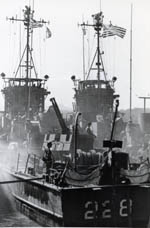 Before the Republic of Vietnam flags were lowered, thousands of people on the ships started to sing the national anthem of South Vietnam, Nay cong dan oi….(Oh, citizens of the country….). “Their voices soared over the waters,” Captain Do recalled. “When they lower the flag, they cry, cry, cry.”
Before the Republic of Vietnam flags were lowered, thousands of people on the ships started to sing the national anthem of South Vietnam, Nay cong dan oi….(Oh, citizens of the country….). “Their voices soared over the waters,” Captain Do recalled. “When they lower the flag, they cry, cry, cry.”
On May 7, the ships, all flying American flags, were allowed to enter Subic Bay. They were eventually transferred to the Philippine navy.
For the Vietnamese it was just the beginning of a long journey to new lives. For the men of Kirk, ending their tour of duty by saving 30,000 Vietnamese refugees had a profound impact on their lives.
“We had gone to Vietnam with the expectation of combat,” Cox recalled. “When we got there we found combat wasn’t needed, but hearts and hands instead. Our experience was totally different from our brothers who walked the fields in combat. We were there to save life, not destroy it.”
“This was the highlight of my career,” Kirk Commander Jacobs said recently. “Most of us never get the chance to command under such stressful circumstances and I’m very proud of what we did.”
Blaming Armitage for the sudden arrival of the VNN fleet and refugees, the Philippine government placed him under house arrest at Subic Bay. “It was fine with me,” Armitage said later. “I ate hamburgers and drank beer for three days.” He also had time to quietly ponder the great escape and humanitarian mission he had successfully led. Of Kirk’s officers and men, Armitage said, “What a great cap to their careers. The ship had not seen combat on its tour to Vietnam. But it ended with the rescue of tens of thousands of refugees, one of the greatest humanitarian missions in the history of the U.S. military. They weren’t burdened with the former misadventure of Vietnam.”
Kirk’s amazing story is perhaps one of the most daring of the entire Vietnam War, and one of the least known. Most Americans only remember the chaos and shame of the last-minute scramble out of Saigon. Kirk’s mission was indeed secret and after its completion, there was likely little desire to stir the diplomatic pot by touting the taking of Vietnam’s navy. In the deluge of news, the Kirk saga went virtually unreported at the time. But, helping to ensure the mission’s obscurity, for 35 years the U.S. Navy had actually misfiled its official accounting that Kirk had even participated in Operation Frequent Wind. Consequently, until Pentagon records were corrected, the crew was ineligible for the Vietnam Service Medal. Finally, in the past two years, the Navy has presented those medals to the officers and enlisted men who were on Kirk during the operation.
In the past year, accounts of the Kirk’s stirring tale have begun to emerge. National Public Radio produced a compelling four-part series, “Forgotten Ship, Daring Rescue,” that aired last fall, and The Lucky Few, a film produced by the U.S. Navy Medicine and Support Command and its historian Jan Herman, was released in late 2010. Herman is now working on a book about the saga.
As for Kirk, uncelebrated in spite of its heroic history, it was without ceremony sold to the navy of Taiwan in 1993, and now sails under the name Fen Yang. Out of a tragic loss, its long-forgotten mission should also be remembered as a victory of the spirit.
Don North was a freelance photographer and later a staff war correspondent for ABC and NBC in Vietnam for more than four years and is a frequent contributor to Vietnam and VietnamMag.com.




